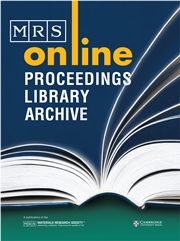Article contents
Simulation of Crystal Growth With Facetted Interfaces
Published online by Cambridge University Press: 21 February 2011
Abstract
We present a method for simulation of crystal growth using completely facetted interfaces and the definition of curvature appropriate to such interfaces. The representation of these surfaces, as facets with fixed normal directions, variable distances, and semi-fixed adjacencies, is quite different from that in other methods. It is flexible as to possible growth rules, it appears to avoid the problems involved in measuring curvature and in detecting and making topological changes, and it runs relatively fast. We expect it to be a valid method to approximate growth with any isotropie or anisotropie surface energy and kinetics. The use of the method is demonstrated in dendritic crystal growth and in Ostwald ripening.
Information
- Type
- Research Article
- Information
- Copyright
- Copyright © Materials Research Society 1992
References
- 8
- Cited by

